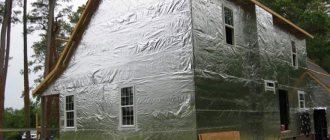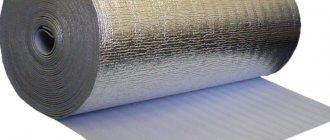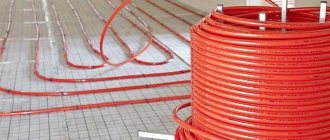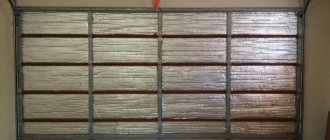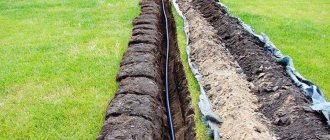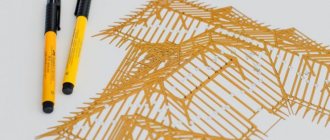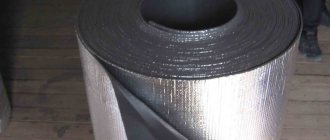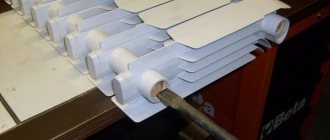A material that does NOT conduct electricity, does NOT allow water to pass through, does NOT emit harmful chemicals, and does NOT allow heat to escape the premises. Four “not” particles describe the properties of one of the best thermal insulators of our time - foamed polyethylene or polyethylene foam (PPE). In order to obtain the material, a lot of experiments were carried out on LDPE (high-density polyethylene) - it was saturated with gases, subjected to diffusion, melted, mixed with additives. The result justified the effort; the result was material that satisfied many requests.
What and how is polyethylene foam sheet made from?
Both high-, low- and medium-pressure polyethylene can be used as feedstock for producing foamed polyethylene.
Dyes, various reagents and additives are also added to the base material. The main method for producing sheet polyethylene foam is extrusion, and at the exit from the die (extrusion head), the polymer almost completely acquires the desired shape (width and thickness).
Using various foaming methods, you can obtain both “cross-linked” and “non-cross-linked” polyethylene foam:
- “cross-linked” is obtained by chemical (by adding foaming and cross-linking reagents to the original polymer) or radiation (by exposing the polymer to an electron beam) methods. As a result, the material acquires a network, cross-linked or spatial molecular structure. Sheets of “cross-linked” polyethylene foam are characterized by higher operating temperatures (up to 200°C) and sufficient strength;
- To obtain “uncrosslinked” polyethylene foam, isobutane, freon or propane-butane is supplied into the chamber of the material cylinder, in which the polymer melts. The structure of molecules does not change after such interaction with gas. However, the foam material obtained in this way has less weight compared to its “cross-linked” counterpart. Its properties are similar to ordinary polyethylene and can also be used at temperatures not exceeding 80°C.
In order to give polyethylene foam sheets any additional properties, they are coated with a one-sided or double-sided coating. For example, with the help of foil they are given the ability to reflect direct sunlight or thermal energy.
It is also possible to apply acrylic glue to a sheet of polyethylene foam, which will greatly facilitate its attachment to any surfaces. The final step is cutting the sheets to the desired size.
What is foamed polyethylene, types of material, production technologies
Foamed polyethylene is a polymer material obtained by introducing a hydrocarbon gas mixture into the polyethylene structure, resulting in a porous, plastic and durable polymer with a cellular structure. It is produced in the form of sheets, strands and rolls.
All foamed polyethylene produced today is divided into three types:
- Unstitched (NPE). The cheapest of the line of foamed polyethylene. Europe launched its production at the end of the last century. The polymer mass melted in the extruder is saturated with gas, usually butane. When poured into a mold, polyethylene enters a zone of atmospheric pressure, gas bubbles try to escape to the surface, and, when solidified, form a cellular structure. Non-crosslinked polyethylene foam is a good heat insulator, but due to its low density and loose, large-porous structure, products made from it are rarely used in construction. The material is mainly used to make packaging.
- Chemically cross-linked (CCPE). The equipment for the production of foamed polyethylene CPPE is used the same as for non-crosslinked polyethylene, but additional processing with hydrogen peroxide is introduced into the technology. This eliminates all the disadvantages inherent in non-crosslinked polyethylene - the material becomes denser, the cells are smaller, the polymer can restore its original shape after deformation.
- Cross-linked by physical or radiation method (FPPE). The most expensive of foamed polyethylenes. The cross-linking of polymer molecules occurs due to the flow of electrons emitted by the emitter. Irradiation forms cross-links that strengthen the molecular network of polyethylene foam. The output is an elastic soft fabric with a smooth surface that can withstand pressure up to 0.035 MPa. Physically and chemically cross-linked PE have similar characteristics, but FPPE recovers its shape faster after loading and adheres better to compacted forms. The floor underlay is made of polyethylene foam produced by radiation.
ABOUT THE MATERIAL
ISOLON NPE is environmentally friendly polyethylene, foamed using a special technology using the latest equipment that allows for multi-stage quality control. ISOLON NPE is a sheet elastic closed-cell material with low apparent density based on food-grade high-density polyethylene, a foaming agent and technological additives. In addition to the main components, NPE grade isolon may contain coloring pigments, fire extinguishing additives, etc. ISOLON NPE-L is produced by heating sheets of Izolon NPE and joining them under pressure. ISOLON NPE is manufactured in the form of a continuous web, wound into a roll or in separate sheets.
| TECHNICAL CHARACTERISTICS OF ISOLON NPE | |
| Apparent density | 26-45 kg/cub.m. |
| Application temperature | from –80°С to +80°С |
| Thermal conductivity | 0.040 W/m.K |
| Specific heat | 1.95 kJ/(kg °C) |
| Water absorption by volume | no more than 0.2% |
| Vapor permeability | 0.001 mg/(m.h.Pa) |
| Sound absorption | From 3% at 125 Hz to 13% at 4000 Hz |
| Compressive stress (25%) | Not less than 0.015 MPa |
| Relative permanent deformation under compression (25%) | No more than 20% |
| Flammability group | G2 - moderately flammable |
| Flammability group | B2 - moderately flammable |
| Smoke generation group | D3 – high smoke-generating ability |
| Combustion product toxicity group | T3 – highly dangerous |
| Electrostatic field strength on the surface of the isolon | 15 kV/m |
Manufactured in accordance with 2244-020-00203476-2004 The quality and complete safety of the ISOLON NPE material is confirmed by all necessary certificates
| Fire safety certificate |
| Certificate of compliance with Russian standards |
| Hygienic certificate, conclusion of the SES of Ukraine |
| Technical certificate of the State Construction Committee of the Russian Federation |
| Certificate of type approval of the Russian Maritime Register of Shipping |
Classification
Polyethylene-based foams are classified according to the following criteria :
- type of feedstock;
- foaming method;
- stitching method.
For the manufacture of PPE, PVD and HDPE granules are used, as well as various compositions based on them. The molecular structure of any type of polyethylene makes it possible to obtain materials with predictable properties.
In the production of polyethylene foam,
two methods are used to create a gaseous phase :
- Physical. This is the direct injection of gas (butane or other light saturated hydrocarbons) into the molten feedstock - the cheapest foaming method. However, it requires the use of specialized equipment and compliance with increased fire safety precautions.
- Chemical. Reagents are introduced into the feedstock, which decompose and release gases. Chemical foaming can be performed on standard foundry and extrusion equipment. The composition of the additives is determined by the requirements for density and cell size.
Modern production technologies make it possible to obtain various molecular structures of gas-filled polyethylene:
- Unstitched (NPE). It is obtained using physical foaming technology. At the same time, polyethylene retains the original structure specified during synthesis. NPE is distinguished by relatively low strength characteristics and its use is justified under conditions of minor mechanical loads.
- Chemically cross-linked (CS-PPE). The technology includes the following stages: mixing raw materials with foaming and cross-linking reagents, forming an initial matrix blank, stepwise heating in a furnace. Heat treatment leads to the formation of cross-links between the polymer threads (crosslinking occurs), and then gas formation occurs. Products made from CS-PPE have a fine-porous structure, a matte surface and higher mechanical properties compared to products made from NPE: strength, tear resistance, elasticity, i.e. the ability to return to its original thickness after compression.
- Physically cross-linked (FS-PPE). The material does not contain crosslinking additives, and instead of the first stage of heat treatment, the matrix blank is treated with an electron flow, which initiates the crosslinking process. The ability to control the number of cross-links allows you to vary the characteristics of the material and cell sizes.
Unlike most structural materials, polyethylene foam is marked not by strength indicators, but by average density, i.e. the ratio of weight per unit volume (kg/m3): 15, 25, 35, 50, 75, 100, ... 500, as for example shown in the photo above.
The method for determining average density is described in GOST 409 - 2017.
Thanks to the work of marketers, domestic consumers are more familiar with the brands of polyethylene foams used, in particular, for pipe thermal insulation:
- Izolon;
- Teploflex;
- Penolon;
- Tatfoum;
- Hitfom;
- Stage, etc.
Product production is most often regulated by internal enterprise standards and technical specifications. However, in Russia, GOST R 56729-2015, corresponding to EN 14313:2009, has been developed for the production of thermal insulation materials.
Main brands on the modern market
Manufacturers of domestic foamed polyethylene: Tepofol, Vilaterm, Izolon, Energoflex (ROLS ISOMARKET), Thermaflex, Polyfom, Penofol, Porilex.
European and American manufacturers of polyethylene foam: DOW, Sealed Air, Pactiv, TROCELLEN, EPE Corporation Group, Alveo.
Every year, up to 185 thousand tons of foamed polyethylene foam are produced around the world. This is a lot. Despite the fact that this market is considered relatively young, the pace of PPE production has already outpaced the production of film, the largest segment of LDPE polyethylene. It is expected that the growth in consumption of this thermal insulator will continue to grow due to the displacement of more expensive substitutes and the use of foamed polyethylene in areas where it was not previously used - in electrical engineering, travel equipment, etc.
The largest manufacturers represented on the market in Russia
The best guide in terms of product quality is the name of the manufacturer. So who can you trust?
- Armacell is a large German company that also produces thermal insulation based on polyethylene foam. It is sold under the Tubolit brand in almost all countries of the world. Products have become synonymous with the highest quality, since their manufacturing technology is constantly being improved, numerous studies are carried out, equipment is updated, and the range is expanded so that the materials are as effective and easy to use as possible. All this allows the company to occupy a leading position in the world.
- Odeflex is a Turkish manufacturer that offers foamed polyethylene in tubes and rolls. A few years ago, the products of this company were widely represented on the domestic market, but now they are increasingly being replaced by national manufacturers.
- Stroytekhizolatsiya LLC is a company located in Belarus and actively exporting its products to the Russian market. The range includes tubes of different thicknesses and diameters intended for thermal insulation of pipelines, air conditioning systems, and industrial systems. They are sold under the name Steinoflex 400 and have a longitudinal cut that facilitates the installation process. Steinophon 290 is also produced - a universal heat and sound insulating material, which is supplied in the form of mats of different thicknesses without coating, or foil-coated on one or both sides.
- Bilaveri is a large Ukrainian manufacturer of foamed polyethylene. The range includes roll material, with or without foil covering, pipe insulation and sealing harnesses. The company values its reputation, therefore it produces only the highest quality products, confirmed by numerous certificates. The manufacturer is widely known on the Ukrainian market and is beginning to conquer the CIS countries.
- Euroizolyatsiya Plus LLC is a domestic company that has been known in the foamed polyethylene market since 2008. The products are known under the Euroizolyatsiya brand and are produced on the most modern equipment using new technologies that are constantly being improved. The quality of manufactured products is supported by relevant documentation, incl. certificate of conformity and sanitary-epidemiological conclusion. The range includes polyethylene foam mats, pipe insulation, damper tape, self-adhesive insulation, underfloor heating, foil insulation.
Izodom LLC is the largest Russian manufacturer of thermal insulation materials made of foamed polyethylene. The company is located in Voronezh, has been operating since 2006, distributes its products throughout the country and to neighboring countries. The manufacturer is trying to constantly improve production technology and expand the range of products, so now its products are represented by a huge range from substrate and reflective insulation to mats and harnesses.- OJSC Izhevsk Plastics Plant is an enterprise that was founded back in 1985. At the beginning of this century, the production of foamed polyethylene was mastered: it is produced both cross-linked and non-cross-linked, and the range of products is constantly expanding.
- ETIOL LLC is a company that was formed in 1991 on the site of Polymersintez OJSC. It is engaged in plastic processing, and recently began producing foamed polyethylene, which is already actively used in various fields throughout the country.
The article was written for the site.
Tags: Sound insulation, Wall insulation
Main advantages of ISOLON NPE
Excellent thermal insulation properties
the material has the lowest thermal conductivity coefficient among insulating materials - 0.040 W/mK with a density of 26 kg/m3. To understand how little heat IZOLON NPE conducts, you can look at the given comparative table of thermal conductivity of various materials
| COMPARATIVE INDICATORS OF THERMAL CONDUCTIVITY OF VARIOUS MATERIALS | |
| ISOLON NPE | 0.040 W/(m K) |
| Steel | 46 W/(m K) |
| Concrete | 0.84 - 1.3 W/(m K) |
| Brick | 0.63 - 0.84 W/(m K) |
| Tree | 0.13 - 0.42 W/(m K) |
| Air at 20ºС | 0.024 W/(mK) |
A 1 cm layer of ISOLON NPE insulation replaces 1.4 cm of polystyrene foam, 16 cm of brickwork, 5 cm of wood!
At the same time, reliable conservation of heat energy, as well as cold (the cost of which is much higher), allows you to feel the economic effect of using Izolon at the very beginning of operation.
Effective protection against moisture and steam
Thanks to its closed-cell structure, isolon practically does not absorb water and, in addition, is an excellent protection against moisture and water vapor throughout the entire volume of the material. Resistance to water vapor diffusion is not limited even for an extremely thin outer layer, and does not exceed 0.2%.
Excellent sound insulation
Sound insulation from knocking and some other noises, combined with low dynamic stiffness and small thickness, gives IZOLON NPE unique sound insulation properties
Environmental Safety
The material is non-toxic and odorless. In the production of ISOLON NPE, freon, a dangerous gas that destroys the ozone layer in the atmosphere, is not used; the material itself is produced on the basis of high-quality food-grade polymer raw materials. Contact with food and human skin is allowed.
Chemical stability
Izolon has good oil, petroleum and petrol resistance, and is also compatible with almost any building materials (for example, concrete, cement, wood, lime, gypsum, etc.)
Durability and performance retention
The polymers from which IZOLON NPE is produced make the product resistant to decay in an environment with any microbiological composition, thus IZOLON NPE does not lose its properties for more than 90 years of operation!
Manufacturability
ISOLON NPE is easy to install. This material, pleasant to the touch, lightweight and elastic, ensures high-tech installation in any conditions. Izolon is easily machined and does not require the use of special devices. Installation requires a knife, stapler, aluminum tape and tape measure.
Purpose
A sheet of foamed polyethylene is used for thermal, moisture-proof and noise insulation in various building and instrument-making structures:
- To protect structural elements of buildings - walls, floors, ceilings, etc.,
- In the manufacture of household and industrial refrigeration equipment,
- As a thermal reflective barrier for heating radiators,
- As a backing for wallpaper, “warm” floors, linoleum and laminate,
- For packaging fragile items with sensitive surfaces and expensive devices, as well as cushioning packaging material.
Available in standard sizes
| DESIGNATION | DESCRIPTION | STANDARD SIZES |
| ISOLON NPE | Foamed polyethylene in rolls | 0.5-1 mm – rolls 1.05 x 200 m 2-10mm – rolls 1.05 x 50 m |
| IZOLON NPE laminated | ISOLON NPE laminated with lavsan film with a durable metallized coating (on one or both sides) | 2,3,4,5,8,10 – rolls 1.0 x 25 m rolls 1.2 x 25 m |
| ISOLON NPE foil | ISOLON NPE laminated with polished aluminum foil (on one or both sides) | 2,3,4,5,8,10 – rolls 1.0 x 25 m rolls 1.2 x 25 m |
| ISOLON NPE self-adhesive | ISOLON NPE with an applied adhesive layer covered with anti-adhesive film or paper | 2,3,4,5,8,10 – rolls 1.0 x 25 m rolls 1.2 x 25 m |
| ISOLON NPE foil self-adhesive | ISOLON NPE laminated with polished aluminum foil on one side and an adhesive layer on the other | 2,3,4,5,8,10 – rolls 1.0 x 25 m rolls 1.2 x 25 m |
| ISOLON NPE-L | ISOLON NPE duplicated by thermal melting | 20,25,30,35,40,45,50 and more mm. – sheets 1.0 x 2.0 m. |
Comparison of manufacturers and prices
Insulation based on polyethylene foam is available in different price categories. Review of manufacturers and average prices:
- Penofol: 1400 rubles/roll – foil covering ( 3 mm, length 30 thousand mm), 2000 rubles/roll – insulation 10 mm thick, 15 thousand mm long.
- Tepofol: with a thickness of 2 mm, the cost is 400 rubles; thickness 5 mm – 1000 rub.
- Energoflex pipe insulation: 15 RUR/roll ( 22x9 mm); 145 RUR/roll ( 110/13 mm).
- Isoflex: 700 RUR/roll ( 25 m length, 2 mm thickness).
If you plan to insulate with polyethylene foam, you should know that the cost is influenced by a number of factors: thickness, length and width of the roll covering. In addition, PPE with a foil layer will cost more than insulation without heat-reflecting material.
Specifications
The main properties and characteristics of foamed polyethylene are as follows:
- The density of PPE depends on the method of its production and is: for FPPE and HPPE - from 33 kg/m3 to 300-500 kg/m3. Non-crosslinked PPE is much lighter. According to the specifications, its density must be at least 20 kg/m3, but in fact, material with a density of 12-18 kg/m3 is sold.
- The temperature of use (from different manufacturers) varies within ± 10 C, but on average, the limits of its operating temperatures range from - 60 C ... + 75 C. In the absence of contact with air, FPPE and HPPE can be used for a short time at temperatures up to +150 C (uncrosslinked up to +100 C). If you use PPE at temperatures below - 60 C, the material becomes brittle, and its residual deformation increases to 35-40%.
- Foamed polyethylene, like all polymers with a closed-porous structure, has a low thermal conductivity coefficient of 0.03-0.38 W/m*K. Foamed polyethylene insulation is second only to polyurethane foam in its heat-saving characteristics.
- Cross-linked and non-cross-linked PPE have different vapor permeability. For non-crosslinked - this figure is within 0.003 mg/m*h*Pa, for cross-linked it is almost three times less - 0.001 mg/m*h*Pa.
Insulation technology
Insulating a bathhouse with penofol
Heat can be lost in the following ways:
- through the floor;
- attic, if it is unheated;
- cracks in windows or doors if they are old wooden;
- through the walls if there are hidden cracks in them.
You can start insulating the room from the internal walls to heat up your apartment or house faster.
To insulate internal walls, it is better to use EPE foiled on one side. You can attach self-adhesive rolled materials to the wall or use a construction stapler.
Work order:
- Spread the roll on the floor and cut it to the required length according to the height of the walls.
- Using a stepladder, attach the top edge of the material to the wall.
- Next, straightening the PE from top to bottom, attach it with small nails with wide heads or a stapler. It is important that the foam insulation fits tightly to the wall.
The joints are connected using aluminum tape.
The second piece of polyethylene foam is applied end-to-end so that there are no empty spaces between the two sheets. After fixing all the joints, they are connected with aluminum tape to prevent heat loss.
To insulate windows and entrance doors, you can use strands of foamed polyethylene, which are sold in different diameters depending on the width of the cracks. The material may have an adhesive surface on one side, so the area is first treated with alcohol to degrease, then PE is attached. According to its characteristics, the new material is better than traditional foam rubber, which turns yellow over time and crumbles under the influence of heat.
It is not recommended to use foil material Penofol for laying under the screed for the following reasons:
- PE is thin and easily crushed under the weight of concrete, so the thermal conductivity characteristics are reduced to a minimum.
- There is nothing left of the foil after a month of use; in addition, it does not work in the absence of IR radiation under a layer of concrete.
- The floating thin screed, which does not have adhesion to the base due to the PE layer, begins to crack due to shrinkage, and along with it the tiles.
For laying under a concrete screed, a special multifoil with large cell sizes is used that do not deform under the weight of concrete.
How can you glue them together?
During the process of laying polyethylene foam, it may be necessary to glue the sheets to each other or to another material. Can be used:
- For connecting VPE – Acrol contact, Quick-Bond, Neoprene 2136, 88 NP.
- To glue foam plastic to another material or glue sheets of foam plastic together - Aqualit SK-106P, Polymin P-20, Super Master, Ceresit or Anserglob.
- To connect the VPE to the wall, it must be cleaned, treated with an antiseptic, dried, then use Nairit-1, Porolon-2, 88 Lux or 88-Metal glue.
Before starting work, you need to think through your actions and foresee what adhesives may be needed in the process.
Advantages and disadvantages
About the advantages of the material:
- Like all foamed polymers, PPE has a low thermal conductivity coefficient - 0.035 W/(m deg).
- The material has good shock-absorbing properties. Foamed polyethylene is used to make: packaging (density 25-33 kg/m3), flooring (density 300 kg/m3), gaskets for equipment (300-500 kg/m3).
- Foamed polyethylene has dielectric properties, so self-extinguishing PPE is used to make electrical insulation for high-frequency cables. The dielectric constant of PPE is in the range of 1.4...1.5 (water - 81, vacuum - 1).
- PPE is an inert material that does not enter into chemical reactions.
- It is also a lightweight and waterproof material; insects and mice do not eat it. And most importantly, it is inexpensive.
It also has disadvantages:
- Foil-coated PPE will work as thermal insulation only if there is at least 2-3 cm of air space in front of the foil layer.
- Above 100 C, the material begins to melt and then burn. It can only be used in rooms with a high specific fire load.
Foil polyethylene and its properties
Foil-coated polyethylene foam is easy to transport and is not damaged by rodents.
Reflective-type PE is used in the construction of heated floors, as well as for sound insulation of ventilation shafts, pipelines, and expansion tanks. The material does not allow steam and water to pass through. It consists of two layers - polyethylene foam and aluminum foil, polished to a degree of reflection of 97%.
Advantages of foil PE:
- There is a certificate of complete safety of the material.
- It is not damaged by rodents, as it is inedible.
- Convenient for transportation.
- Fire safety. In domestic conditions it is impossible to reach high temperatures at which PE ignites.
- It insulates heat and sound at the same time. In this case, it is laid in a thin layer.
- A layer of 4 mm can replace mineral wool 8 cm thick.
To install foil polyethylene, there is no need to use a vapor-permeable film, since the material itself conducts water molecules well. Compared to mineral wool it is worse, but condensation does not accumulate.
Disadvantages:
- PE with foil is very soft, so it is not used for plaster and wallpaper.
- For wall mounting, adhesive materials are used, since it is impossible to attach foil-coated polyethylene in any other way. The use of nails violates the thermal insulation properties.
Varieties of foiled polyethylene
To insulate external walls, PE with foil is used as additional protection from moisture and to reflect heat into the walls.
There are several types of foil insulation:
- Marking A is PE, covered on one side with aluminum foil.
- B – coating on both sides. It is used for interfloor ceilings as a separate insulation material.
- C – one side is foil-coated, the other is covered with adhesive for ease of installation.
- ALP – One side is foil and laminated film, the other side is uncoated.
- Markings M and R – corrugated PE, covered on one side with foil.
Only polyethylene has thermal insulating properties. If it is used for laying under concrete, the aluminum layer does not perform its functions, since there is no radiant heat.
The use of foil-clad PE in rooms with short-wave infrared floor heating may result in accumulation of rays and burns of the skin and retina of the eyes. This property does not apply to long-wave IR heaters.
Basic properties
The technical characteristics of foamed PE are a synthesis of the properties of polyethylenes, soft elastic materials with a low melting point, and foamed substances with their light weight and low thermal conductivity:
- Like regular polyethylene, foamed PE is a flammable material, the maximum operating temperature of which should not exceed +102°C. At higher rates it will melt.
- At low temperatures, even when dropped to -60°C, foamed polyethylene will retain all its properties, including strength and elasticity.
- The thermal conductivity of this product is very low, it is 0.038-0.039 W/m*K, which gives products made from it a particularly high thermal insulation coefficient.
- In direct contact with water, foamed PE absorbs it by no more than 1-3.5% of its volume per month.
- Foamed polyethylene is very resistant to chemically active environments, in particular to oil and gasoline products.
- Does not degrade in a biologically active environment (does not rot, is not susceptible to the action of bacteria and fungus).
- It absorbs sounds perfectly, so PPE can be used for sound insulation.
- Absolutely non-toxic, even during combustion.
- Easy to transport and install,
- Wear-resistant and durable up to 80 - 100 years of service.
Flaws
A negative property of foamed PE is its intolerance to ultraviolet rays. Direct exposure to sunlight has a destructive effect on it, therefore both storage and use of foamed polyethylene should take place in places protected from light. Otherwise, the material itself must contain protection, at least in the form of an opaque film.
Products made of polyethylene foam and their scope
Pipe shells are pipe shells with a clearly defined internal diameter. They can be produced with a ready-made technological cut along the entire length (for mounted pipes) or without a cut. Shells for pipes running outdoors are made with a protective polymer coating. Used as thermal insulation for utility hot water supply systems and air conditioning systems. Available with an outer diameter of 6-114 mm, foam thickness of polyethylene 6-25 mm.
Compensation mats - used as shock-absorbing thermal insulation in places where hot water pipelines turn, for heat and sound insulation of walls, partitions, and floors. Mats are obtained by gluing panels of foamed polyethylene. The process occurs at high temperatures, so the body of the damping mat is an inextricable structure that is resistant to external damage. Compensation mats made of polyethylene foam are supplied in sheets, the standard size is 1x2 m, thickness from 10 to 100 mm.
The harnesses are a cylindrical seal made of foamed polyethylene; products are produced with an outer diameter of Ø 6-120 mm. 1. Bundles Ø 6-12 mm are laid in expansion joints of concrete floors. Ø 12-20 mm seal the gaps between the wall and door or window frames. Well, the largest bundles in the range, Ø 20-60 mm, are used to fill joints in the walls of panel houses.
Substrate - made of physically and chemically cross-linked PPE. Available in rolls up to 3 meters wide and 2-5 mm thick. A polyethylene foam backing is used as a backing layer between the screed and the laminate.
Packaging polyethylene foam. Packaging usually uses uncrosslinked polyethylene foam in the form of rolls and bags of different sizes and thicknesses (0.5-20 mm). But there are also containers made to order - various inserts, protective corners. Polyethylene foam bags are the most popular type of packaging. They do not allow water to pass through, are durable, absorb shock and reduce vibration of the cargo during transportation. To make the bag more durable and improve its heat-insulating properties, it is covered on top with metallized polypropylene or regular film, nylon, or kraft paper. Packaging material made of polyethylene foam is used for transporting electrical equipment, furniture, dishes, and shoes.
Installation
Installation of PPE is simple and convenient.
Polyethylene foam pipe insulation can be used in:
- cold and hot water supply systems;
- heating systems;
- sewerage;
- ventilation;
- as well as on pipes of refrigeration units.
The installation instructions are very simple.
If the pipeline is at the assembly stage , then:
- The shell is put on the pipe like a stocking.
- Then the joints are glued with special glue.
- Next, the joints are sealed with metallized tape.
The joints of the PPE are sealed with metallized tape.
If the pipeline is already assembled and welded , then:
PACKAGING FOR FURNITURE AND APPLIANCES
- ISOLON NPE-01 and NPE-02 are designed specifically for packaging household appliances, furniture and other expensive products that require careful storage and transportation. They are ideal for preserving the presentation of any product, glass, porcelain, polished surfaces made of any materials.
- ISOLON NPE has universal protective properties, protects against impacts and scratches, contamination, including petroleum products, the harmful effects of low temperatures, any leaks and fumes, direct sunlight, the spread of an unfavorable microbiological environment,
- Due to its complete environmental safety confirmed by a sanitary and epidemiological certificate, the material can be recommended as packaging for dishes, children's toys, and other products that require increased attention to the safety of materials, including packaging.
- Carefully preserving the presentation of the product, IZOLON NPE itself outwardly differs favorably from most packaging materials, absolutely even and smooth, pleasant to the eye, soft to the touch, the material, by its appearance, emphasizes the quality of the packaged product.
Production and features of polyethylene foam
Polyethylene foam is made by processing high-density polyethylene (LDPE), to which dyes, refractory reagents and other hydrocarbon compounds are added.
For manufacturing, the extrusion method is used, which results in foamed polyethylene with a large number of closed pores with air inside. After this, the material is subjected to heat treatment and foaming at a temperature of 180°, and, if necessary, the finished material is then cross-linked. Cross-linked polyethylene foam is produced by radiation or chemical means. Polyethylene, reaction catalysts and antioxidant substances are melted, brought to a thermoplastic state, and then sheets are formed and stitched together. Non-crosslinked polyethylene foam is formed by foaming ordinary polyethylene with a propane-butane mixture or freons.
Features of the material
Among the main features of polyethylene foam, the following should be highlighted:
- Excellent thermal conductivity, allowing the use of polyethylene foam for thermal insulation. Thermal conductivity indicators of foamed polyethylene - 0.037 W/m*K
- Reduced hygroscopicity. This property allows the material to be used as a protective barrier against liquids and moisture.
- High-quality sound insulation. The physical properties of the material make it possible to use it as sound insulation not only in construction, but also in mechanical engineering.
- The permissible operating temperature range is 240 degrees.
- Strength and wear resistance. The material is not exposed to biologically aggressive environments, insects and other external factors.
Let us note an interesting fact: 1 cm thick polyethylene foam easily replaces a 15 cm brickwork or a 5 cm layer of mineral wool.
Construction
One of the main reasons for the massive use of foamed polyethylene in construction is the physical properties of the material. It is actively used to provide heat and sound insulation, and for waterproofing walls, floors and ceilings. The ability of the material to dampen vibrations allows it to be used to protect pipelines from mechanical damage, as well as to ensure silence and absence of vibration of air ducts; as a sealant for joints in prefabricated elements of reinforced concrete and other structures. The permissible temperature for using insulation is in the range from -60 to +80 °C, which creates all the necessary conditions for all-season installation. Work on thermal insulation of objects does not depend on external air temperature and can be carried out 365 days a year. Due to the combination of heat, wind, steam, hydro and sound insulation simultaneously when using foamed polyethylene, there is no need to use additional films and membranes.
Features of application
The entire PPE sheet can be held in your hands and easily applied to the surface it covers. Cutting it is not difficult at all - here you only need simple scissors. Even an untrained person can handle the installation of sheet thermal insulation, subject to the following few rules:
- Reflective surfaces should always “look” into the room,
- Fastening is done using glue or a construction stapler,
- The joints must be taped with tape, plain or metallized,
- A gap of at least 2.5-3 mm is required between the insulation sheet and other surfaces, otherwise the thermal insulation effect will be significantly reduced.
Production stages.
- Polyethylene granules are loaded into a hopper where they are melted. Polyethylene melting point 115 degrees
- Carbon dioxide or nitrogen is supplied to the molten material, with their help the polyethylene is structurized. Foaming can be carried out in 2 ways: physical or chemical.
- To obtain a homogeneous mass, the hopper rotates continuously. Changes occur in the material at the molecular level.
- Next, the finished mass enters the injection mold and is cooled.
Kinds
Today, many types of foamed polyethylene are produced, differing in the following parameters:
- Type of base polyethylene: High-density polyethylene (LDPE),
- Made from low-density polyethylene (HDPE), etc.
- Non-crosslinked foamed PE, foamed with physical blowing agents. Preserves the original molecular structure of polyethylene.
- foamy,
In addition, for ease of use, foamed PE can be produced in different forms: sheet, tile, tube, film, etc. and with coatings made of various materials (foil, etc.)
Application area
Foamed polyethylene is widely used as an insulating and heat-preserving material, which is explained by the high performance of all its technical characteristics, the variety of forms produced, as well as the comparative low cost of its production:
- As thermal, sound and waterproofing of elements of various building structures (foundations, floors, walls and roofs, ventilation systems),
- As an insulating material in automobile and instrument making (for car interior decoration, ship cabins, sound insulation of military equipment),
- For sealing door elements, double-glazed windows, laminate underlays and in combination with other insulating products,
- As a shaping and insulating material in the production of sports equipment, backpacks and safety helmets,
- As a shipping package for shoes, various equipment, household appliances and much more.
